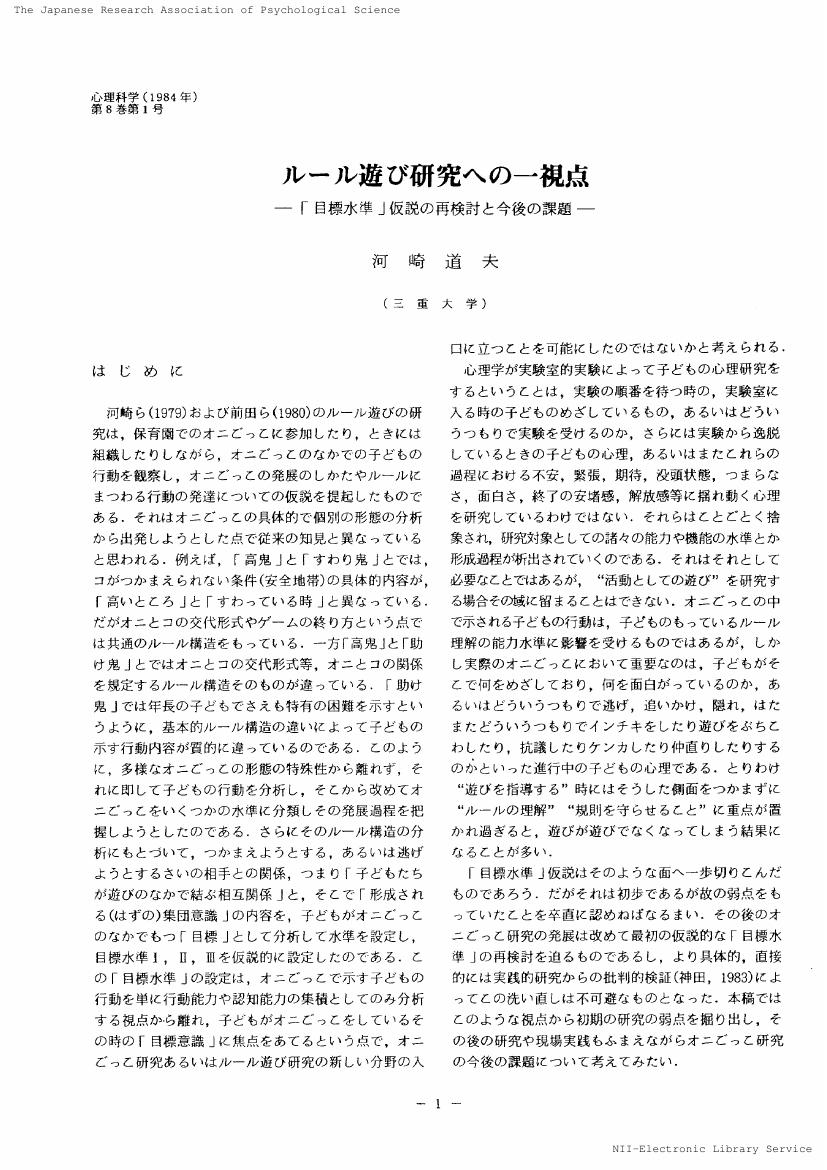- 著者
- 河崎 道夫
- 出版者
- 日本保育学会
- 雑誌
- 保育学研究 (ISSN:13409808)
- 巻号頁・発行日
- vol.46, no.1, pp.12-21, 2008-08-30
- 被引用文献数
- 3
There have been two radical changes in the history of children's play in the past half-century in Japan. The first change began in the 1960s: the period of Japanese rapid economic growth. During this period, children began to lose the three essential factors of play: time, space, and company. Gradually, fewer and fewer children were seen playing outdoors, such as running around with their friends. Many kinds of children's play that had accumulated over time as historical constructs began to be lost. This fundamental change continued, with the second radical change occurring in the late 1980s. At that time, technological development of electronic devices and expressive media produced massive amounts of expressive cultural goods for children such as game software, video software, and picture books. These artificial, fantastical, and imaginative products created a big market targeted at children. Consequently, children's interactive play with the real world, especially nature, changed into play with expressive electronic cultural products. This tendency changed children's play radically from interactive, physical, and creative play to more passive activities. Today, children are likely to play alone indoors without physical activities. It is feared that these changes will have harmful effects on children's mental and physical development.
2 0 0 0 OA 歴史的構成体としての子どもの遊びの変容
- 著者
- 河崎 道夫
- 出版者
- 一般社団法人 日本保育学会
- 雑誌
- 保育学研究 (ISSN:13409808)
- 巻号頁・発行日
- vol.46, no.1, pp.12-21, 2008-08-30 (Released:2017-08-04)
- 被引用文献数
- 1
There have been two radical changes in the history of children's play in the past half-century in Japan. The first change began in the 1960s: the period of Japanese rapid economic growth. During this period, children began to lose the three essential factors of play: time, space, and company. Gradually, fewer and fewer children were seen playing outdoors, such as running around with their friends. Many kinds of children's play that had accumulated over time as historical constructs began to be lost. This fundamental change continued, with the second radical change occurring in the late 1980s. At that time, technological development of electronic devices and expressive media produced massive amounts of expressive cultural goods for children such as game software, video software, and picture books. These artificial, fantastical, and imaginative products created a big market targeted at children. Consequently, children's interactive play with the real world, especially nature, changed into play with expressive electronic cultural products. This tendency changed children's play radically from interactive, physical, and creative play to more passive activities. Today, children are likely to play alone indoors without physical activities. It is feared that these changes will have harmful effects on children's mental and physical development.
- 著者
- 河崎 道夫 権部 良子 浅田 美知子 藤本 尚 井本 賢治 吉田 京子
- 出版者
- 三重大学
- 雑誌
- 三重大学教育学部附属教育実践総合センター紀要 (ISSN:13466542)
- 巻号頁・発行日
- vol.25, pp.9-16, 2005-03
- 被引用文献数
- 1
本研究会(幼小連携接続問題研究協議会)は、幼小連携問題について、(1)児童間交流と教員間交流、(2)教育課程の再編、(3)養成課程の改革を三つの課題として取り組んでいる。これまでは(1)全体の取り組みの計画を構造化するとともに、児童間交流の問題を中心とした実践的研究を報告してきた。今回は、(1)3年間にわたり継続的に児童間交流を進めてきた実践の成果と課題を総括すること、(2)2年目となる教育課程の改訂への取り組みの中間報告と今後の展望をまとめた。
1 0 0 0 OA 自分の名を言うこととはどういうことか?
- 著者
- 河崎 道夫 黒太 綾乃
- 出版者
- 心理科学研究会
- 雑誌
- 心理科学 (ISSN:03883299)
- 巻号頁・発行日
- vol.26, no.1, pp.41-55, 2006-02-28 (Released:2017-09-10)
This study investigated the manner in which children refer to themselves and others during very early childhood. With this objective, a boy between 15 and 28 months of age was observed by his mother (Kurota, one of the authors) at their home. He first started naming people, at 15 months, when he addressed both to his father and mother as "paapa." Subsequently, he indiscriminately addressed his two grandfathers as "Jiiji" (grandpa), his two grandmothers as "Baaba" (grandma), and interstingly his aunt as "Neene." At 19 months he began to refer to himself by his own name. After he positioned himself in this "small society" by referring to himself and his familiar others, his flaming of people was rapidly expanded to include other people like his mother's friends, thek children, and even his grandmother's pet dog. Through the encounter with this "slightly larger society", the boy was able to differentiate and assign names to the members of this "small society." At 24 months he intentionally called himself by "mumm" and reversely called his mother by his name. In Japan, particularly in the presense of children, many adults refer to themselves and each others by the "role names to be called from the viewpoint of the children." For instance, fathers would refer to themselves as "dad", their wives as "mum" and their sisters "auntie." In Japan young children begin to identify others and themselves in the same manner as the members of the "small society" refer to each others and themselves. It is suggested that the way in which children refer to themselves, in other words, the way they stand up to themselves is largely affected by social and cultural factors.
1 0 0 0 OA ルール遊び研究への一視点 : 「目標水準」仮説の再検討と今後の課題(<特集>遊び)
- 著者
- 河崎 道夫
- 出版者
- 心理科学研究会
- 雑誌
- 心理科学 (ISSN:03883299)
- 巻号頁・発行日
- vol.8, no.1, pp.1-8, 1984-09-30 (Released:2017-09-10)
1 0 0 0 OA 幼児におけるルール遊びの発達 : その1 仮説構成の試み
- 著者
- 河崎 道夫 田中 浩司
- 出版者
- 心理科学研究会
- 雑誌
- 心理科学 (ISSN:03883299)
- 巻号頁・発行日
- vol.27, no.1, pp.95-96, 2007-03-28 (Released:2017-09-10)
1 0 0 0 OA 発達論における能動性と社会性カテゴリーについて
- 著者
- 河崎 道夫
- 出版者
- 心理科学研究会
- 雑誌
- 心理科学 (ISSN:03883299)
- 巻号頁・発行日
- vol.1, no.1, pp.3-10, 1977-04-30 (Released:2017-09-10)
1 0 0 0 インターネットスクール開設等による理科教育改善の研究
【1】インターネットスクール「三重仮想大学:http://www-press.hep.phen.mie-u.ac.jp/mievu」の開設(1)インターネットスクールで開講している講座・中学生向けの「自然と人間」…………………………………………………同/shizen/index.html・大学生向けの「宇宙・地球の誕生と自然の構造」……………………………同/uchuu/index.html・市民向けの「量子と宇宙」……………………………………同/ryoushiuchuu/index.html・市民向けの「量子と波」…………………………………………同/ryoushinami/index.html・市民向けの「量子・宇宙・ひも」……………………………………………………同/qus/index.html・大学生および院生向けの「あべちゃんの物理学講座」…………同/ryoushiuchuu/index.html・大学院生向けの「Introduction to High Energy Physics」………………同/ryoushiuchuu/index.html・研究者向けの「Topics on High Energy Physics」…………………………同/topics/index.html・研究会報告「非摂動論的弦模型と世代構造」…………………………………………………同/research01/index.html(2)インターネットスクールにおける「動画:同/movie/index.html」の放映・芦原すなお講演「小説とぼく」…………………………………………………1997年の三重大学学術文化祭から・共通教育シンポジウム「新しい教養教育を考える」…………………………1997年の三重大学学術文化祭から・1997年の三重大学生物資源学部公開講座…………………………林拙郎講演「三重の水と森林」他9つの映像・2000年度三重大学総合科目「宇宙・地球の誕生と自然の構造」で実施した6イベント中の3映像【2】高等・中等教育における教育実践研究(1)毎年度(1998〜2000年度)三重大学共通教育総合科目「宇宙・地球の誕生と自然の構造」を開講(2)2001年2月に三重大学教育学部附属中学校1年「総合的な学習」の時間に「自然と人間」を開講(3)1998年8月に3日間の「高校生のインターネット講座」を開講(4)1999年8月および2000年8月にそれぞれ3日間の「中学生のインターネット講座」を開講
- 著者
- 河崎 道夫
- 出版者
- 心理科学研究会
- 雑誌
- 心理科学 (ISSN:03883299)
- 巻号頁・発行日
- vol.24, no.2, 2004-05-31
- 著者
- 河崎 道夫 田中 浩司
- 出版者
- 心理科学研究会
- 雑誌
- 心理科学 (ISSN:03883299)
- 巻号頁・発行日
- vol.27, no.1, pp.95-96, 2007-03-28





